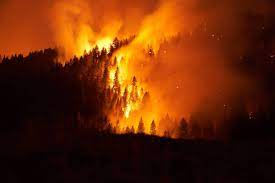Op Rana
While the world’s attention was focused on the Maui wildfires in Hawaii, and rightly so given the high death toll (115 with about 1,000 people reported missing) and scale of devastation (economic loss of about $6 billion), the Canadian, Greek and Spanish governments were also struggling to control wildfires in different parts of their countries. The wildfires in Canada (about 1,000 in number) are especially destructive, having already scorched more than 15 million hectares in Quebec, Ontario and other regions. And while Spain has evacuated thousands of people from the island of Tenerife to save them from the wrath of raging infernos, Greece has seen 35 people falling victims to conflagrations.
Blame the wildfires, if you will, on El Nino, which according to the US National Oceanic and Atmospheric Administration is likely to remain strong for the next six months because of sizzling ocean temperatures in the east-central tropical Pacific in July. The world, except for the climate skeptics and vested interests, knows why the east-central tropical Pacific has been sizzling. As a consequence of global warming, more than half of the oceans have become greener in the past two decades, the peer-review science journal Nature reported in July.
The warming of the Earth, however, is not only about heat waves, melting glaciers and drying water bodies, which, not to be mistaken, are more than alarming. Global warming also results in erratic and unusually heavy rainfall, and floods. China has experienced both forms climate-related devastation this year. While June and July saw many parts of China in the grip of extreme heat, with temperatures reaching record highs in Beijing, early August saw the opening up of the sky, with Beijing experiencing the heaviest downpour in 140 years and parts of Hebei province encountering devastating floods. True, Typhoon Doksuri in late July was responsible for the deluge, but typhoons rarely were so destructive earlier. By the way, July was the hottest month on record. This month has also seen the mountainous Indian province of Himachal Pradesh being battered by record downpours and landslides. With rain continuing to wreak havoc in Himachal Pradesh, comes the latest weather forecast of more, heavier downpours, posing flooding threats to the neighboring province of Punjab, which has already suffered two major floods in the past month. The tragedy which has already claimed 238 lives in Himachal is being blamed on melting glaciers, shrinking snow cover and increasing rain, all because of climate change.
If the developed countries and emerging market economies are struggling to adapt to climate change, we cannot even imagine what the condition of the least-developed and Pacific island countries is like. The least said about the people native to these countries the better. Their plight is manifested in the waves of refugees making their way to Europe’s coasts, braving dangerous currents in decrepit ferries and steamers. These people, exploited by human traffickers, are not only fleeing poverty and wars in African countries; they are also trying to escape the wrath of climate change. They are, first of all, climate refugees. And yet world leaders, especially leaders of the developed world, continue to pay lip service to climate action. They are, it seems, guided, if not controlled, by big business, which in turn is guided by the profit mantra. As long as the dollars keep flowing, it will be business as usual. The world leaders are expected to meet at the 28th United Nations Climate Change Conference (COP28) in Dubai, United Arab Emirates, from Nov 30 to Dec 12, and resume from where they left in Sharm el-Sheikh in Egypt in 2022. They will again, like they did at COP26 in Glasgow, Scotland, in 2021, reaffirm the Paris Agreement goal of limiting the average increase in the global temperature to well below 2 degrees Celsius above pre-industrial levels and pursuing efforts to limit it to 1.5 C. The same commitments will be made, the same negotiations will reverberate in Dubai Expo City, the venue of the conference, and the same hopes will be raised only to be forgotten.
Had our world leaders been even half as serious as they pretend to be, they wouldn’t have allowed $1.4 trillion of public money, according to the International Institute for Sustainable Development, to be pumped into fossil fuels last year. Or, if you believe the International Monetary Fund, allowed fossil fuels to enjoy subsidies worth $13 million per minute in 2022, which adds up to an astronomical $7 trillion for the whole year. Perhaps a better way of fighting climate change is the one chosen by six Portuguese children and young adults. The young guns have moved the European Court of Human Rights against 32 European countries, accusing their leaders of not doing enough to combat climate change. Such is their determination and so strong is their case that the ECHR has referred the matter to the 17-judge Grand Chamber. For the record, the ECHR has referred only 0.03 percent of the cases to the Grand Chamber in its history. If the six young climate activists are successful, the 32 European countries will be legally bound to ramp up emissions cuts as well as reduce their overall contribution to climate change including their exports, especially fossil fuel exports. The world belongs to young activists, and only they can save it from doom.
The China Daily







